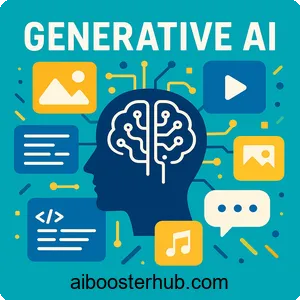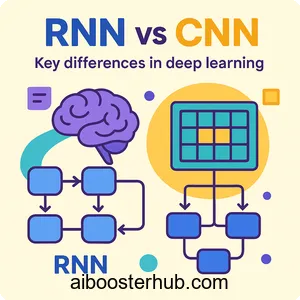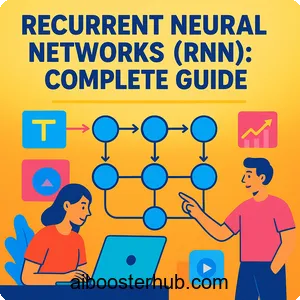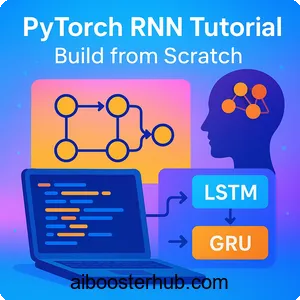Autoencoders in Deep Learning: VAE and Sparse Autoencoders
Autoencoders represent one of the most elegant and powerful concepts in deep learning. These neural network architectures have revolutionized how we approach unsupervised learning, dimensionality reduction, and generative modeling. Whether you’re working on image compression, anomaly detection, or creating synthetic data, understanding autoencoders is essential for any AI practitioner.
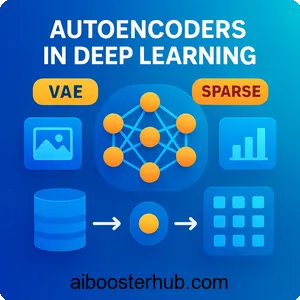
In this comprehensive guide, we’ll explore what autoencoders are, how they work, and dive deep into two important variants: variational autoencoders (VAE) and sparse autoencoders. You’ll learn the fundamental concepts, see practical implementations, and understand when to use each type of autoencoder in your deep learning projects.
Content
Toggle1. What is an autoencoder?
An autoencoder is a type of artificial neural network designed to learn efficient representations of data in an unsupervised manner. The core idea is deceptively simple: train a network to reconstruct its input data by first compressing it into a lower-dimensional representation, then reconstructing the original data from this compressed form.
The architecture consists of two main components:
Encoder: This component compresses the input data into a latent space representation (also called the bottleneck or code). The encoder learns to extract the most important features from the input while discarding redundant information.
Decoder: This component takes the compressed representation and attempts to reconstruct the original input. The decoder learns to map the latent representation back to the original data space.
The encoder and decoder architecture
The encoder decoder architecture works through a series of transformations. Let’s consider a simple example with image data:
- Input layer: Receives the original data (e.g., a 28×28 pixel image = 784 dimensions)
- Encoder layers: Progressive compression through hidden layers (784 → 256 → 128 → 64)
- Latent space: The bottleneck layer (e.g., 32 dimensions)
- Decoder layers: Progressive expansion back to original size (32 → 64 → 128 → 256 → 784)
- Output layer: Reconstructed data matching input dimensions
The training objective is to minimize the reconstruction error between the input and output. The loss function typically used is:
$$ L = \frac{1}{n} \sum_{i=1}^{n} ||x_i – \hat{x}_i||^2 $$
where \(x_i\) is the original input and \(\hat{x}_i\) is the reconstructed output.
Why autoencoders matter in deep learning
Autoencoders have become fundamental deep learning models for several reasons:
Dimensionality reduction: Unlike traditional methods like PCA (Principal Component Analysis), autoencoders can learn non-linear transformations, making them more powerful for complex data. They’re particularly effective when dealing with high-dimensional data like images or text.
Feature learning: The latent representations learned by autoencoders often capture meaningful features of the data. These features can be used for downstream tasks like classification or clustering.
Neural network compression: By forcing information through a bottleneck, autoencoders learn to retain only the most important aspects of the data, effectively compressing neural networks.
Anomaly detection: Since autoencoders learn to reconstruct normal data, they struggle with anomalous inputs, producing high reconstruction errors that can be used for detection.
Here’s a simple implementation of a basic autoencoder using Python and PyTorch:
import torch
import torch.nn as nn
import torch.optim as optim
class SimpleAutoencoder(nn.Module):
def __init__(self, input_dim=784, latent_dim=32):
super(SimpleAutoencoder, self).__init__()
# Encoder
self.encoder = nn.Sequential(
nn.Linear(input_dim, 256),
nn.ReLU(),
nn.Linear(256, 128),
nn.ReLU(),
nn.Linear(128, latent_dim)
)
# Decoder
self.decoder = nn.Sequential(
nn.Linear(latent_dim, 128),
nn.ReLU(),
nn.Linear(128, 256),
nn.ReLU(),
nn.Linear(256, input_dim),
nn.Sigmoid() # For normalized inputs [0,1]
)
def forward(self, x):
# Encode
latent = self.encoder(x)
# Decode
reconstructed = self.decoder(latent)
return reconstructed
# Training example
model = SimpleAutoencoder()
criterion = nn.MSELoss()
optimizer = optim.Adam(model.parameters(), lr=0.001)
# Training loop (simplified)
def train_autoencoder(model, data_loader, epochs=10):
model.train()
for epoch in range(epochs):
total_loss = 0
for batch_data in data_loader:
# Flatten images if needed
batch_data = batch_data.view(batch_data.size(0), -1)
# Forward pass
reconstructed = model(batch_data)
loss = criterion(reconstructed, batch_data)
# Backward pass
optimizer.zero_grad()
loss.backward()
optimizer.step()
total_loss += loss.item()
print(f"Epoch {epoch+1}, Loss: {total_loss/len(data_loader):.4f}")
2. Understanding variational autoencoders (VAE)
While standard autoencoders learn deterministic mappings, variational autoencoders introduce a probabilistic approach that makes them powerful generative models. The VAE framework combines ideas from Bayesian inference with neural networks to learn a probability distribution over the latent space.
What makes VAE different?
The key innovation of variational autoencoders is that instead of encoding an input as a single point in latent space, they encode it as a probability distribution. Specifically, the encoder outputs parameters of a distribution (typically mean and variance for a Gaussian distribution) rather than a fixed vector.
This probabilistic approach offers several advantages:
Generative capability: By sampling from the learned distribution, you can generate new data points that resemble the training data. This makes VAE a true generative model.
Smooth latent space: The probabilistic nature encourages a continuous and smooth latent space where similar inputs are mapped to nearby regions. This interpolation property is valuable for many applications.
Regularization: The probabilistic formulation naturally regularizes the latent space, preventing overfitting and ensuring meaningful representations.
The VAE architecture and loss function
A variational autoencoder consists of three main components:
Encoder (Recognition network): Maps input (x) to distribution parameters \(\mu\) and \(\sigma\) in latent space
Sampling layer: Samples latent vector \(z\) from \(N(\mu, \sigma^2)\) using the reparameterization trick
Decoder (Generative network): Reconstructs the input from sampled \(z\)
The VAE loss function combines two terms:
$$ L_{VAE} = L_{reconstruction} + \beta \cdot L_{KL} $$
where:
Reconstruction loss measures how well the decoder reconstructs the input:
$$L_{\text{reconstruction}} = \mathbb{E}_{q_{\phi}(z|x)}\!\left[ \| x – \hat{x} \|^2 \right]$$
KL divergence loss measures how close the learned distribution is to a prior (usually standard normal):
$$ L_{KL} = D_{KL}(q_\phi(z|x) || p(z)) = -\frac{1}{2}\sum_{j=1}^{J}(1 + \log(\sigma_j^2) – \mu_j^2 – \sigma_j^2) $$
The \(\beta\) parameter controls the trade-off between reconstruction quality and latent space regularization.
Implementing a variational autoencoder
Here’s a complete implementation of a VAE in Python:
import torch
import torch.nn as nn
import torch.nn.functional as F
class VAE(nn.Module):
def __init__(self, input_dim=784, latent_dim=20):
super(VAE, self).__init__()
# Encoder
self.fc1 = nn.Linear(input_dim, 400)
self.fc_mu = nn.Linear(400, latent_dim) # Mean
self.fc_logvar = nn.Linear(400, latent_dim) # Log variance
# Decoder
self.fc3 = nn.Linear(latent_dim, 400)
self.fc4 = nn.Linear(400, input_dim)
def encode(self, x):
h1 = F.relu(self.fc1(x))
return self.fc_mu(h1), self.fc_logvar(h1)
def reparameterize(self, mu, logvar):
"""Reparameterization trick: z = mu + sigma * epsilon"""
std = torch.exp(0.5 * logvar)
eps = torch.randn_like(std) # Sample from standard normal
return mu + eps * std
def decode(self, z):
h3 = F.relu(self.fc3(z))
return torch.sigmoid(self.fc4(h3))
def forward(self, x):
mu, logvar = self.encode(x)
z = self.reparameterize(mu, logvar)
return self.decode(z), mu, logvar
def vae_loss(reconstructed, original, mu, logvar, beta=1.0):
"""
VAE loss = Reconstruction loss + KL divergence
"""
# Reconstruction loss (Binary Cross Entropy)
BCE = F.binary_cross_entropy(reconstructed, original, reduction='sum')
# KL divergence loss
KLD = -0.5 * torch.sum(1 + logvar - mu.pow(2) - logvar.exp())
return BCE + beta * KLD
# Training example
vae_model = VAE(latent_dim=20)
optimizer = optim.Adam(vae_model.parameters(), lr=1e-3)
def train_vae(model, data_loader, epochs=10, beta=1.0):
model.train()
for epoch in range(epochs):
total_loss = 0
for batch_data in data_loader:
batch_data = batch_data.view(batch_data.size(0), -1)
# Forward pass
reconstructed, mu, logvar = model(batch_data)
loss = vae_loss(reconstructed, batch_data, mu, logvar, beta)
# Backward pass
optimizer.zero_grad()
loss.backward()
optimizer.step()
total_loss += loss.item()
print(f"Epoch {epoch+1}, Loss: {total_loss/len(data_loader):.4f}")
# Generate new samples
def generate_samples(model, num_samples=10):
model.eval()
with torch.no_grad():
# Sample from standard normal distribution
z = torch.randn(num_samples, model.fc_mu.out_features)
samples = model.decode(z)
return samples
Applications of variational autoencoders
Variational autoencoders excel in several domains:
Image generation: VAE can generate realistic images by sampling from the latent space. While not as sharp as GANs, they offer more stable training and better latent space structure.
Data augmentation: By interpolating between examples in latent space, you can create new training samples that help improve model generalization.
Anomaly detection: Normal data reconstructs well, while anomalies produce high reconstruction errors or have low probability under the learned distribution.
Representation learning: The latent representations learned by VAE can be used as features for other machine learning tasks.
3. Sparse autoencoders explained
While variational autoencoders focus on probabilistic modeling, sparse autoencoders take a different approach to learning useful representations. The core idea is to encourage sparsity in the learned representations, meaning only a small subset of neurons should be active for any given input.
The concept of sparsity in neural networks
Sparsity in neural networks refers to having most activation values close to zero, with only a few neurons firing strongly. This concept is inspired by biological neural networks, where neurons tend to respond to specific patterns rather than being active all the time.
The benefits of sparsity include:
Better interpretability: Sparse representations are easier to understand because each feature corresponds to a specific aspect of the data.
Reduced overfitting: By limiting the number of active neurons, sparse autoencoders naturally regularize the network.
Efficient computation: Sparse representations require less computation and storage.
Feature disentanglement: Different neurons learn to represent distinct features, reducing redundancy.
Sparse autoencoder architecture and loss function
A sparse autoencoder has the same basic encoder decoder architecture as a standard autoencoder, but adds a sparsity constraint to the training objective. The modified loss function is:
$$ L_{sparse} = L_{reconstruction} + \lambda \cdot L_{sparsity} $$
where \(\lambda\) controls the strength of the sparsity penalty.
The most common sparsity penalty is the KL divergence between the average activation of hidden units and a target sparsity level \(\rho\):
$$L_{\text{sparsity}} = \sum_{j=1}^{s} D_{KL}(\rho \, \| \, \hat{\rho}_j)
= \sum_{j=1}^{s} \left[ \rho \log\frac{\rho}{\hat{\rho}_j} + (1 – \rho) \log\frac{1 – \rho}{1 – \hat{\rho}_j} \right]$$
where:
- \(s\) is the number of hidden units
- \(\rho\) is the target sparsity parameter (e.g., 0.05 means we want 5% average activation)
- \(\hat{\rho}_j = \frac{1}{m} \sum_{i=1}^{m} a_j^{(i)}\) is the average activation of hidden unit \(j\) over the training set
Implementation of a sparse autoencoder
Here’s how to implement a sparse autoencoder in Python:
import torch
import torch.nn as nn
import torch.optim as optim
class SparseAutoencoder(nn.Module):
def __init__(self, input_dim=784, hidden_dim=256, latent_dim=64):
super(SparseAutoencoder, self).__init__()
# Encoder
self.encoder = nn.Sequential(
nn.Linear(input_dim, hidden_dim),
nn.Sigmoid(), # Use sigmoid for sparsity constraint
nn.Linear(hidden_dim, latent_dim),
nn.Sigmoid()
)
# Decoder
self.decoder = nn.Sequential(
nn.Linear(latent_dim, hidden_dim),
nn.Sigmoid(),
nn.Linear(hidden_dim, input_dim),
nn.Sigmoid()
)
def forward(self, x):
encoded = self.encoder(x)
decoded = self.decoder(encoded)
return decoded, encoded
def kl_divergence_sparsity(rho, rho_hat):
"""
KL divergence for sparsity constraint
rho: target sparsity (e.g., 0.05)
rho_hat: actual average activation
"""
return rho * torch.log(rho / rho_hat) + \
(1 - rho) * torch.log((1 - rho) / (1 - rho_hat))
def sparse_autoencoder_loss(reconstructed, original, encoded,
rho=0.05, beta=0.3):
"""
Loss = Reconstruction loss + Sparsity penalty
"""
# Reconstruction loss
mse_loss = nn.MSELoss()(reconstructed, original)
# Sparsity penalty
rho_hat = torch.mean(encoded, dim=0) # Average activation per neuron
# Add small epsilon to avoid log(0)
epsilon = 1e-10
rho_hat = torch.clamp(rho_hat, epsilon, 1 - epsilon)
sparsity_loss = torch.sum(kl_divergence_sparsity(rho, rho_hat))
return mse_loss + beta * sparsity_loss
# Training example
sparse_model = SparseAutoencoder()
optimizer = optim.Adam(sparse_model.parameters(), lr=0.001)
def train_sparse_autoencoder(model, data_loader, epochs=10,
rho=0.05, beta=0.3):
model.train()
for epoch in range(epochs):
total_loss = 0
for batch_data in data_loader:
batch_data = batch_data.view(batch_data.size(0), -1)
# Forward pass
reconstructed, encoded = model(batch_data)
loss = sparse_autoencoder_loss(reconstructed, batch_data,
encoded, rho, beta)
# Backward pass
optimizer.zero_grad()
loss.backward()
optimizer.step()
total_loss += loss.item()
print(f"Epoch {epoch+1}, Loss: {total_loss/len(data_loader):.4f}")
# Analyze sparsity
def analyze_sparsity(model, data_loader):
model.eval()
all_activations = []
with torch.no_grad():
for batch_data in data_loader:
batch_data = batch_data.view(batch_data.size(0), -1)
_, encoded = model(batch_data)
all_activations.append(encoded)
all_activations = torch.cat(all_activations, dim=0)
avg_activation = torch.mean(all_activations, dim=0)
print(f"Average activation per neuron: {avg_activation.mean():.4f}")
print(f"Percentage of neurons with activation < 0.1: "
f"{(avg_activation < 0.1).sum().item() / len(avg_activation) * 100:.2f}%")
When to use sparse autoencoders
Sparse autoencoders are particularly useful in several scenarios:
Feature extraction: When you need interpretable features for downstream tasks, sparse representations make it easier to understand what each feature represents.
Image processing: In computer vision, sparse autoencoders can learn edge detectors and texture features similar to those in early visual cortex.
Text analysis: For natural language processing, sparse representations can capture semantic concepts where each neuron represents a specific topic or theme.
Anomaly detection: The sparsity constraint makes the autoencoder more sensitive to unusual patterns, improving anomaly detection performance.
4. Comparing autoencoder variants
Understanding when to use each type of autoencoder is crucial for successful implementation. Let’s compare the three main variants we’ve discussed: standard autoencoders, variational autoencoders, and sparse autoencoders.
Performance characteristics
Standard autoencoders:
- Best for: Dimensionality reduction, simple compression tasks
- Strengths: Fast training, straightforward implementation, good reconstruction
- Limitations: Latent space may have gaps, not ideal for generation, can overfit easily
Variational autoencoders:
- Best for: Generative tasks, learning smooth representations
- Strengths: Can generate new samples, continuous latent space, principled probabilistic framework
- Limitations: Often produces blurry reconstructions, more complex to train, computationally expensive
Sparse autoencoders:
- Best for: Feature learning, interpretable representations
- Strengths: Interpretable features, better generalization, biologically inspired
- Limitations: Requires careful tuning of sparsity parameters, slower convergence
Choosing the right autoencoder
Here’s a practical decision tree for selecting the appropriate autoencoder type:
Standard autoencoders are ideal when:
- You need fast, simple dimensionality reduction
- Reconstruction quality is the primary concern
- You’re working with relatively small datasets
- You don’t need to generate new samples
Variational autoencoders work best when:
- You need to generate new data samples
- Smooth latent space interpolation is important
- You’re building generative models
- You want a probabilistic framework
Sparse autoencoders excel when:
- Interpretability of learned features is crucial
- You’re extracting features for downstream tasks
- You want biologically plausible representations
- You need robust anomaly detection
Hybrid approaches
In practice, you can combine different autoencoder techniques to leverage their respective strengths:
Sparse VAE: Combines the generative power of variational autoencoders with sparsity constraints for more interpretable latent representations.
Convolutional autoencoders: Uses convolutional layers instead of fully connected layers, particularly effective for image data. Can be combined with VAE or sparsity constraints.
Denoising autoencoders: Trained to reconstruct clean data from corrupted inputs, can be combined with any autoencoder variant for improved robustness.
Here’s an example of a hybrid Convolutional VAE:
import torch
import torch.nn as nn
import torch.nn.functional as F
class ConvVAE(nn.Module):
def __init__(self, latent_dim=128):
super(ConvVAE, self).__init__()
# Encoder
self.encoder = nn.Sequential(
nn.Conv2d(1, 32, kernel_size=4, stride=2, padding=1), # 28x28 -> 14x14
nn.ReLU(),
nn.Conv2d(32, 64, kernel_size=4, stride=2, padding=1), # 14x14 -> 7x7
nn.ReLU(),
nn.Conv2d(64, 128, kernel_size=7, stride=1, padding=0), # 7x7 -> 1x1
)
self.fc_mu = nn.Linear(128, latent_dim)
self.fc_logvar = nn.Linear(128, latent_dim)
# Decoder
self.fc_decode = nn.Linear(latent_dim, 128)
self.decoder = nn.Sequential(
nn.ConvTranspose2d(128, 64, kernel_size=7, stride=1, padding=0),
nn.ReLU(),
nn.ConvTranspose2d(64, 32, kernel_size=4, stride=2, padding=1),
nn.ReLU(),
nn.ConvTranspose2d(32, 1, kernel_size=4, stride=2, padding=1),
nn.Sigmoid()
)
def encode(self, x):
x = self.encoder(x)
x = x.view(x.size(0), -1)
return self.fc_mu(x), self.fc_logvar(x)
def reparameterize(self, mu, logvar):
std = torch.exp(0.5 * logvar)
eps = torch.randn_like(std)
return mu + eps * std
def decode(self, z):
z = self.fc_decode(z)
z = z.view(z.size(0), 128, 1, 1)
return self.decoder(z)
def forward(self, x):
mu, logvar = self.encode(x)
z = self.reparameterize(mu, logvar)
return self.decode(z), mu, logvar
5. Advanced techniques and optimization
As you become more comfortable with autoencoders, several advanced techniques can significantly improve their performance and applicability to complex problems.
Regularization strategies
Beyond basic L2 regularization, several specialized techniques help autoencoders learn better representations:
Denoising: Train the autoencoder to reconstruct clean data from corrupted inputs. This forces the network to learn robust features rather than simply copying the input.
def add_noise(x, noise_factor=0.3):
"""Add Gaussian noise to input"""
noisy = x + noise_factor * torch.randn_like(x)
return torch.clamp(noisy, 0., 1.)
# Training with denoising
def train_denoising_autoencoder(model, data_loader, noise_factor=0.3):
model.train()
for batch_data in data_loader:
# Add noise to input
noisy_data = add_noise(batch_data, noise_factor)
# Train to reconstruct original clean data
reconstructed = model(noisy_data)
loss = criterion(reconstructed, batch_data)
# Optimization step
optimizer.zero_grad()
loss.backward()
optimizer.step()
Contractive autoencoders: Add a penalty term that encourages the learned representations to be locally invariant to small changes in the input:
$$ L_{contractive} = L_{reconstruction} + \lambda ||\frac{\partial h}{\partial x}||_F^2 $$
where \(h\) is the encoder output and \(||\cdot||_F\) is the Frobenius norm.
Weight tying: Share weights between encoder and decoder (decoder weights are transpose of encoder weights). This reduces parameters and can improve generalization.
Architectural improvements
Residual connections: Adding skip connections between encoder and decoder layers can improve gradient flow and reconstruction quality, especially for deeper networks.
Attention mechanisms: Incorporating attention allows the autoencoder to focus on relevant parts of the input, particularly useful for sequential or spatial data.
Progressive training: Start with small latent dimensions and gradually increase complexity. This curriculum learning approach can lead to better convergence.
Hyperparameter tuning
Critical hyperparameters that significantly impact autoencoder performance:
Latent dimension size: Too small and you lose information; too large and you may overfit. Start with dimensions that compress input by 10-20x, then adjust based on reconstruction quality.
Learning rate schedule: Use learning rate warmup for VAE to stabilize early training, then decay over time. A typical schedule:
def get_learning_rate_schedule(optimizer, warmup_epochs=5):
"""Learning rate schedule with warmup"""
def lr_lambda(epoch):
if epoch < warmup_epochs:
return (epoch + 1) / warmup_epochs
return 0.95 ** (epoch - warmup_epochs)
return optim.lr_scheduler.LambdaLR(optimizer, lr_lambda)
scheduler = get_learning_rate_schedule(optimizer)
Beta parameter for VAE: Start with (\beta = 0) and gradually increase to 1.0 (beta-annealing). This helps the model first learn to reconstruct, then learn the regularized latent space.
Sparsity target for sparse autoencoders: Typical values range from 0.01 to 0.1. Lower values produce sparser representations but may hurt reconstruction quality.
Practical tips for training
Monitor multiple metrics: Don’t just track overall loss. For VAE, separately monitor reconstruction loss and KL divergence. For sparse autoencoders, track average activation levels.
Visualize reconstructions regularly: During training, periodically save input-output pairs to visually assess quality. This catches issues that metrics might miss.
Check latent space structure: For VAE, visualize the latent space (use t-SNE or PCA for high dimensions) to ensure it’s continuous and organized.
Use appropriate batch sizes: Larger batches (128-512) typically work better for autoencoders as they provide more stable gradient estimates.
Early stopping: Monitor validation loss and stop training when it plateaus to avoid overfitting.
6. Real-world applications and case studies
Autoencoders have proven their value across numerous domains. Let’s explore concrete applications where different autoencoder variants excel.
Image compression and processing
Autoencoders provide learned compression that adapts to specific types of images. Unlike traditional codecs like JPEG, neural network compression can be optimized for particular domains.
Example: Medical image compression
Medical imaging requires high fidelity to preserve diagnostic information. A specialized autoencoder can achieve better compression ratios than general-purpose methods while maintaining critical details:
class MedicalImageAutoencoder(nn.Module):
def __init__(self):
super(MedicalImageAutoencoder, self).__init__()
# Encoder with attention to important regions
self.encoder = nn.Sequential(
nn.Conv2d(1, 64, 3, stride=2, padding=1),
nn.BatchNorm2d(64),
nn.ReLU(),
nn.Conv2d(64, 128, 3, stride=2, padding=1),
nn.BatchNorm2d(128),
nn.ReLU(),
nn.Conv2d(128, 256, 3, stride=2, padding=1),
nn.BatchNorm2d(256),
nn.ReLU()
)
# Decoder with skip connections for detail preservation
self.decoder = nn.Sequential(
nn.ConvTranspose2d(256, 128, 3, stride=2, padding=1, output_padding=1),
nn.BatchNorm2d(128),
nn.ReLU(),
nn.ConvTranspose2d(128, 64, 3, stride=2, padding=1, output_padding=1),
nn.BatchNorm2d(64),
nn.ReLU(),
nn.ConvTranspose2d(64, 1, 3, stride=2, padding=1, output_padding=1),
nn.Sigmoid()
)
def forward(self, x):
encoded = self.encoder(x)
decoded = self.decoder(encoded)
return decoded
Anomaly detection
Autoencoders excel at detecting unusual patterns because they learn to reconstruct normal data. Anomalies produce high reconstruction errors.
Example: Manufacturing defect detection
Train an autoencoder on images of normal products. During inference, products with defects will have high reconstruction error:
def detect_anomalies(model, image, threshold=0.05):
"""
Detect anomalies using reconstruction error
Returns: is_anomaly (bool), reconstruction_error (float)
"""
model.eval()
with torch.no_grad():
reconstructed = model(image)
# Calculate reconstruction error
error = F.mse_loss(reconstructed, image, reduction='none')
error = error.view(error.size(0), -1).mean(dim=1)
is_anomaly = error > threshold
return is_anomaly, error
# Example usage
anomaly_detected, error_value = detect_anomalies(model, test_image)
if anomaly_detected:
print(f"Anomaly detected! Error: {error_value:.4f}")
Example: Network intrusion detection
Sparse autoencoders work well for cybersecurity applications, where network traffic patterns need monitoring:
class NetworkTrafficSparseAutoencoder(nn.Module):
def __init__(self, input_features=41): # Standard network traffic features
super(NetworkTrafficSparseAutoencoder, self).__init__()
self.encoder = nn.Sequential(
nn.Linear(input_features, 30),
nn.ReLU(),
nn.Linear(30, 15),
nn.Sigmoid() # Sparsity constraint
)
self.decoder = nn.Sequential(
nn.Linear(15, 30),
nn.ReLU(),
nn.Linear(30, input_features)
)
def forward(self, x):
encoded = self.encoder(x)
decoded = self.decoder(encoded)
return decoded, encoded
# Train on normal traffic, then use for intrusion detection
def detect_intrusion(model, traffic_sample, threshold=0.1):
model.eval()
with torch.no_grad():
reconstructed, _ = model(traffic_sample)
error = F.mse_loss(reconstructed, traffic_sample)
if error > threshold:
return True, error.item() # Intrusion detected
return False, error.item() # Normal traffic
Recommendation systems
Autoencoders can learn user preferences and item features for collaborative filtering. The latent space captures complex relationships between users and items.
Example: Movie recommendation system
class CollaborativeFilteringAutoencoder(nn.Module):
def __init__(self, num_items, latent_dim=50):
super(CollaborativeFilteringAutoencoder, self).__init__()
# Encoder: User ratings -> User preferences
self.encoder = nn.Sequential(
nn.Linear(num_items, 256),
nn.SELU(),
nn.Dropout(0.5),
nn.Linear(256, latent_dim),
nn.SELU()
)
# Decoder: User preferences -> Predicted ratings
self.decoder = nn.Sequential(
nn.Linear(latent_dim, 256),
nn.SELU(),
nn.Dropout(0.5),
nn.Linear(256, num_items)
)
def forward(self, x):
# Encode user rating patterns
user_embedding = self.encoder(x)
# Predict ratings for all items
predicted_ratings = self.decoder(user_embedding)
return predicted_ratings
def recommend_items(self, user_ratings, top_k=10):
"""Generate top-k recommendations for a user"""
self.eval()
with torch.no_grad():
predictions = self.forward(user_ratings)
# Mask already rated items
predictions[user_ratings > 0] = -float('inf')
# Get top-k recommendations
top_items = torch.topk(predictions, top_k)
return top_items.indices, top_items.values
Drug discovery and molecular generation
Variational autoencoders have found exciting applications in computational chemistry. They can learn representations of molecular structures and generate novel compounds with desired properties.
Example: Molecular VAE for drug design
class MolecularVAE(nn.Module):
"""
VAE for molecular SMILES strings
SMILES: Simplified Molecular Input Line Entry System
"""
def __init__(self, vocab_size, max_length=120, latent_dim=56):
super(MolecularVAE, self).__init__()
self.max_length = max_length
self.latent_dim = latent_dim
# Encoder: SMILES -> Latent space
self.encoder_embedding = nn.Embedding(vocab_size, 128)
self.encoder_gru = nn.GRU(128, 256, num_layers=3, batch_first=True)
self.fc_mu = nn.Linear(256, latent_dim)
self.fc_logvar = nn.Linear(256, latent_dim)
# Decoder: Latent space -> SMILES
self.decoder_latent = nn.Linear(latent_dim, 256)
self.decoder_gru = nn.GRU(256, 256, num_layers=3, batch_first=True)
self.decoder_fc = nn.Linear(256, vocab_size)
def encode(self, x):
embedded = self.encoder_embedding(x)
_, hidden = self.encoder_gru(embedded)
hidden = hidden[-1] # Take last layer
mu = self.fc_mu(hidden)
logvar = self.fc_logvar(hidden)
return mu, logvar
def reparameterize(self, mu, logvar):
std = torch.exp(0.5 * logvar)
eps = torch.randn_like(std)
return mu + eps * std
def decode(self, z, max_length):
batch_size = z.size(0)
# Initialize decoder
hidden = self.decoder_latent(z).unsqueeze(0).repeat(3, 1, 1)
# Generate sequence
decoder_input = z.unsqueeze(1).repeat(1, max_length, 1)
output, _ = self.decoder_gru(decoder_input, hidden)
logits = self.decoder_fc(output)
return logits
def forward(self, x):
mu, logvar = self.encode(x)
z = self.reparameterize(mu, logvar)
logits = self.decode(z, x.size(1))
return logits, mu, logvar
def generate_molecule(self, property_vector=None):
"""Generate novel molecular structure"""
self.eval()
with torch.no_grad():
if property_vector is None:
# Sample from prior
z = torch.randn(1, self.latent_dim)
else:
# Generate with specific properties
z = property_vector
logits = self.decode(z, self.max_length)
tokens = torch.argmax(logits, dim=-1)
return tokens
Natural language processing
Autoencoders can learn semantic representations of text, useful for tasks like paraphrasing, text generation, and semantic search.
Example: Sentence VAE for paraphrase generation
class SentenceVAE(nn.Module):
def __init__(self, vocab_size, embedding_dim=300, hidden_dim=512, latent_dim=128):
super(SentenceVAE, self).__init__()
# Shared embedding layer
self.embedding = nn.Embedding(vocab_size, embedding_dim)
# Encoder (Bidirectional LSTM)
self.encoder_lstm = nn.LSTM(embedding_dim, hidden_dim,
bidirectional=True, batch_first=True)
self.fc_mu = nn.Linear(hidden_dim * 2, latent_dim)
self.fc_logvar = nn.Linear(hidden_dim * 2, latent_dim)
# Decoder (LSTM)
self.decoder_lstm = nn.LSTM(embedding_dim + latent_dim, hidden_dim,
batch_first=True)
self.decoder_fc = nn.Linear(hidden_dim, vocab_size)
def encode(self, x, lengths):
embedded = self.embedding(x)
# Pack padded sequence for efficiency
packed = nn.utils.rnn.pack_padded_sequence(
embedded, lengths, batch_first=True, enforce_sorted=False
)
_, (hidden, _) = self.encoder_lstm(packed)
# Concatenate forward and backward final states
hidden = torch.cat([hidden[-2], hidden[-1]], dim=1)
mu = self.fc_mu(hidden)
logvar = self.fc_logvar(hidden)
return mu, logvar
def decode(self, z, target_seq, lengths):
embedded = self.embedding(target_seq)
# Concatenate latent vector with each timestep
z_expanded = z.unsqueeze(1).expand(-1, embedded.size(1), -1)
decoder_input = torch.cat([embedded, z_expanded], dim=2)
output, _ = self.decoder_lstm(decoder_input)
logits = self.decoder_fc(output)
return logits
def generate_paraphrase(self, input_sentence, temperature=1.0):
"""Generate paraphrase by sampling from latent space"""
self.eval()
with torch.no_grad():
# Encode input
mu, logvar = self.encode(input_sentence, [input_sentence.size(1)])
# Sample with temperature
std = torch.exp(0.5 * logvar) * temperature
eps = torch.randn_like(std)
z = mu + eps * std
# Decode to generate paraphrase
# Implementation of autoregressive generation...
return z # Returns latent representation
7. Conclusion
Autoencoders represent a fundamental architecture in deep learning that continues to evolve and find new applications across diverse domains. From the basic encoder decoder architecture to sophisticated variants like variational autoencoders and sparse autoencoders, these models provide powerful tools for unsupervised learning, dimensionality reduction, and generative modeling.
Throughout this guide, we’ve explored how autoencoders work, examined different variants and their unique characteristics, and seen practical implementations across various real-world applications. Whether you’re compressing images, detecting anomalies, generating new molecules, or building recommendation systems, autoencoders offer flexible and effective solutions. The key to success lies in understanding the strengths and limitations of each variant, carefully tuning hyperparameters for your specific use case, and leveraging advanced techniques like denoising and attention mechanisms when appropriate.
As deep learning models continue to advance, autoencoders remain relevant by adapting to new challenges and integrating with other architectures. By mastering these foundational concepts and staying current with emerging techniques, you’ll be well-equipped to apply autoencoders effectively in your AI projects and contribute to this exciting field’s continued innovation.

